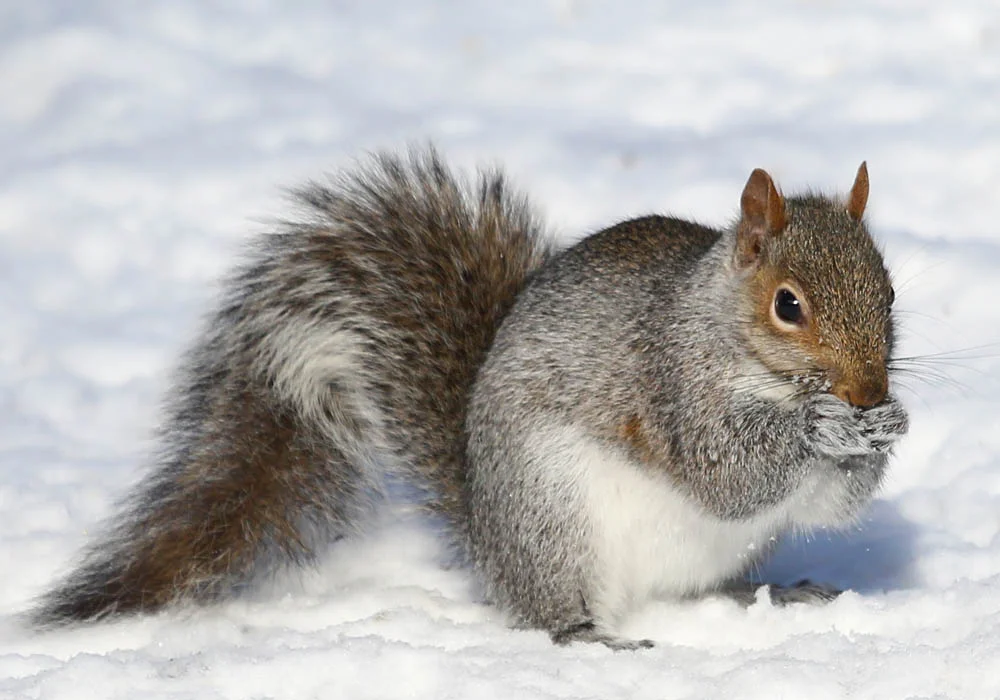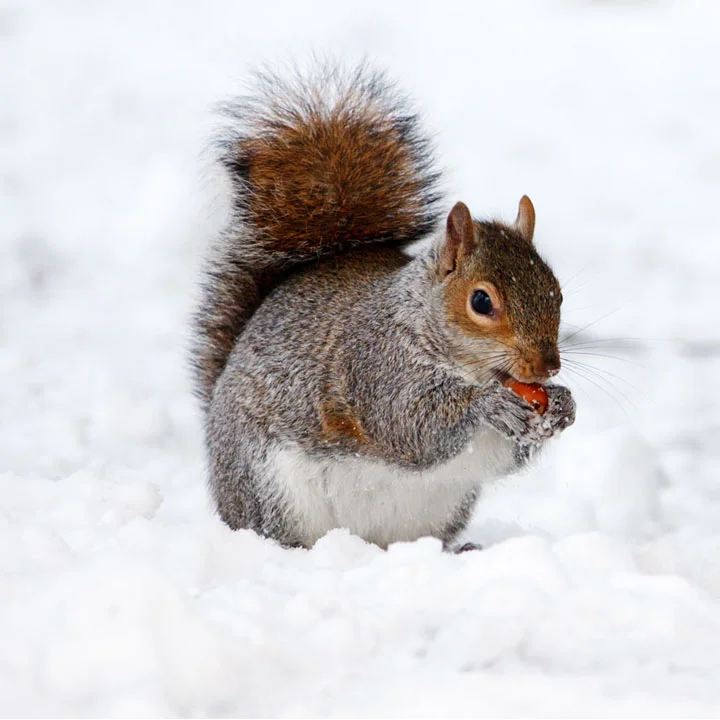
As winter approaches and temperatures begin to drop, many animals take significant measures to ensure their survival through the harshest season of the year. Among these resilient creatures are squirrels, known for their agile movements and bushy tails. But how do squirrels survive in the winter? How do these small mammals manage to thrive when food is scarce, and the weather is unforgiving? In this article, we delve into the fascinating strategies squirrels employ to survive the winter, shedding light on their behaviors, physiological adaptations, and survival techniques.
Since food is scarce in the winter, you may be wondering what to feed squirrels in the winter. However, you don’t need to do that! One of the primary ways squirrels prepare for winter is through food hoarding. During the warmer months, squirrels engage in food caching, where they collect and store food in various locations. This behavior is critical for their winter survival, as it ensures they have a steady food supply when resources become scarce. If you’re wondering what the best food for squirrels in winter is, the answer is that squirrels have all the food they need in their caches.
Squirrels are known for their impressive ability to remember the locations of their food caches, so feeding squirrels in the winter is unnecessary. They use spatial memory and cues from the environment to locate buried nuts, seeds, and other food items. This remarkable memory helps them retrieve their food stores even when the ground is covered in snow. You may have heard that wintertime affects the size of squirrels’ brains, so if you were asking “Do squirrels' brains get bigger in the winter?”, the answer is that one study found that, because of this use of their memory, their brains might get a bit bigger during wintertime!
Squirrels employ different types of food caches to maximize their chances of survival. These include:

As winter approaches, squirrels undergo physiological changes to help them withstand the cold. One significant adaptation is the accumulation of body fat. During the fall, squirrels consume large quantities of high-calorie foods to build up fat reserves. This extra fat serves as an energy source during the winter when food is scarce.
Squirrels possess several adaptations that help them regulate their body temperature in cold weather. Their thick fur coat provides insulation, trapping heat close to their bodies. Additionally, squirrels can fluff up their fur to increase its insulating properties, creating a warmer microenvironment around their bodies.
While some animals hibernate during the winter, squirrels typically do not enter true hibernation. Instead, they experience periods of torpor, a state of reduced metabolic activity. During torpor, squirrels lower their body temperature and heart rate to conserve energy. Unlike hibernation, torpor is a temporary state, and squirrels can wake up periodically to forage for food.
Squirrels build nests, known as dreys, to provide shelter and warmth during the winter. These nests are typically constructed from twigs, leaves, and other plant materials. Squirrels often build dreys high in trees, offering protection from predators and the elements.
In addition to dreys, squirrels may seek refuge in tree cavities or burrows. These enclosed spaces provide additional insulation and protection from harsh weather conditions.
During the winter, squirrels' diets shift to accommodate the availability of food. While they primarily rely on their cached food stores, they may also consume other available resources, such as:

In some species, such as the gray squirrel, individuals may engage in communal nesting. Multiple squirrels share a single nest, which helps them conserve body heat and maintain warmth during cold nights. This behavior is particularly common among young squirrels and siblings.
Squirrels use vocalizations and body language to communicate with one another, especially during the winter when they need to warn each other of potential dangers or share information about food sources. These communication methods help them navigate their environment more effectively and avoid predators.
During the winter, squirrels are more vulnerable to predators due to food scarcity and the need to forage more frequently. To mitigate this risk, squirrels rely on camouflage and increased vigilance. Their fur often changes color to blend in with the winter landscape, making them less conspicuous to predators.
Squirrels are agile climbers and use their speed and agility to escape from predators. They can quickly ascend trees and leap between branches to evade capture. Additionally, their ability to change direction rapidly helps them avoid predators on the ground.

Squirrels are highly adaptable creatures that have successfully made their homes in urban environments. Cities and suburban areas offer a wealth of food sources and nesting opportunities, which squirrels have learned to exploit. In urban settings, squirrels may find food in bird feeders, garbage cans, and gardens, providing them with a reliable supply of nutrition throughout the winter.
In some cases, humans inadvertently aid in the survival of squirrels during the winter. Bird feeders, for example, provide a consistent source of food that squirrels can access. If you want to know how to help squirrels in the winter, some people intentionally leave out food for squirrels, such as nuts and seeds, to help them survive the cold months. While this can be beneficial, it is essential to provide appropriate food types and avoid feeding squirrels processed or unhealthy foods. However, if you’re wondering “Should I feed squirrels in the winter?” the answer is that it’s best to leave squirrels alone, as they have more than enough survival strategies to make it through the winter without help from humans.
While urban environments can offer resources, human activities can also pose threats to squirrels. Vehicle traffic, domestic pets, and habitat destruction can all negatively impact squirrel populations. Despite these challenges, squirrels have demonstrated remarkable resilience and ability to coexist with humans.
Scientists and researchers have long been fascinated by squirrels' ability to survive winter. Studies on squirrel behavior, physiology, and ecology provide valuable insights into their survival strategies. Research often involves tracking and observing squirrels in both natural and urban settings, using methods such as GPS collars and motion-activated cameras.
Conservation efforts aim to protect squirrel populations and their habitats. This includes preserving natural woodlands, promoting urban green spaces, and educating the public about the importance of wildlife conservation. By creating environments that support squirrel populations, we can help ensure their continued survival and biodiversity.
Organizations and wildlife groups often engage in educational outreach to raise awareness about squirrels and their role in ecosystems. Programs may include school visits, public talks, and the distribution of informative materials. These efforts help foster a greater appreciation for squirrels and encourage community involvement in conservation.

Climate change poses new challenges for squirrels and other wildlife. Warmer winters can disrupt the natural behaviors and physiological processes that squirrels rely on for survival. For instance, less predictable snowfall patterns can affect food caching and retrieval, while unseasonably warm temperatures may interfere with their periods of torpor.
Squirrels' adaptability may help them cope with some of the effects of climate change. However, ongoing research is essential to understand the full impact and develop strategies to support squirrel populations. Conservationists and scientists are working to monitor changes and implement measures to protect these resilient creatures.
Communities can be vital in supporting squirrel populations by creating and maintaining squirrel-friendly habitats. Planting native trees and shrubs, preserving existing woodlands, and providing safe nesting sites can all contribute to a healthier environment for squirrels.
If you choose to feed squirrels, it is important to do so responsibly. Providing a mix of nuts, seeds, and fruits can supplement their diet without causing dependency on human-provided food. Avoid giving squirrels processed foods or items high in salt and sugar, as these can be harmful to their health.
Wildlife corridors are essential for allowing squirrels and other animals to move safely between habitats. These corridors can include tree-lined streets, green belts, and connected parks. By promoting and preserving these pathways, communities can help ensure that squirrels have access to the resources they need throughout the year.
Squirrels are remarkable examples of nature's resilience and adaptability. Their ability to prepare for and survive the winter through a combination of behavioral, physiological, and social strategies is truly inspiring. By understanding and supporting these creatures, we can contribute to their well-being and appreciate the intricate balance of our ecosystems.
Whether in natural woodlands or bustling urban environments, squirrels continue to thrive, showcasing their ingenuity and determination. As we face new environmental challenges, the story of the squirrel's winter survival reminds us of the importance of conservation and the role we play in protecting the wildlife that shares our world.
If squirrels become a nuisance in your attic or home during the wintertime, it's important to seek professional help for humane removal. Critter Stop, a professional wildlife removal company, has a five-star reputation for high-quality work and excellent service to commercial and residential customers in Texas. We specialize in humane squirrel removal and ensure that these creatures won’t enter your property again. Contact Us at (214) 234-2616 and book your free inspection and estimate today!
Visit our Critter Library and learn more about our furry friends